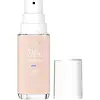What's inside
What's inside
 Key Ingredients
Key Ingredients

 Benefits
Benefits

 Concerns
Concerns

 Ingredients Side-by-side
Ingredients Side-by-side

Water
Skin ConditioningDimethicone
EmollientIsododecane
EmollientCyclohexasiloxane
EmollientGlycerin
HumectantPEG-10 Dimethicone
Skin ConditioningMethyl Methacrylate Crosspolymer
Butylene Glycol
HumectantPentylene Glycol
Skin ConditioningSynthetic Fluorphlogopite
Disteardimonium Hectorite
StabilisingHydroxyethylpiperazine Ethane Sulfonic Acid
BufferingCetyl PEG/PPG-10/1 Dimethicone
EmulsifyingSodium Chloride
MaskingPolyglyceryl-4 Isostearate
EmulsifyingHexyl Laurate
EmollientCaprylyl Glycol
EmollientPhenoxyethanol
PreservativeDisodium Stearoyl Glutamate
CleansingTocopherol
AntioxidantSilica
AbrasivePanthenol
Skin ConditioningAluminum Hydroxide
EmollientHydroxyethyl Urea
HumectantAloe Barbadensis Leaf Juice Powder
Skin ConditioningSodium Hyaluronate
HumectantPentaerythrityl Tetra-Di-T-Butyl Hydroxyhydrocinnamate
AntioxidantTitanium Dioxide
Cosmetic ColorantCI 77491
Cosmetic ColorantCI 77492
Cosmetic ColorantCI 77499
Cosmetic ColorantCI 77007
Cosmetic ColorantCI 77288
Cosmetic ColorantWater, Dimethicone, Isododecane, Cyclohexasiloxane, Glycerin, PEG-10 Dimethicone, Methyl Methacrylate Crosspolymer, Butylene Glycol, Pentylene Glycol, Synthetic Fluorphlogopite, Disteardimonium Hectorite, Hydroxyethylpiperazine Ethane Sulfonic Acid, Cetyl PEG/PPG-10/1 Dimethicone, Sodium Chloride, Polyglyceryl-4 Isostearate, Hexyl Laurate, Caprylyl Glycol, Phenoxyethanol, Disodium Stearoyl Glutamate, Tocopherol, Silica, Panthenol, Aluminum Hydroxide, Hydroxyethyl Urea, Aloe Barbadensis Leaf Juice Powder, Sodium Hyaluronate, Pentaerythrityl Tetra-Di-T-Butyl Hydroxyhydrocinnamate, Titanium Dioxide, CI 77491, CI 77492, CI 77499, CI 77007, CI 77288
Isododecane
EmollientWater
Skin ConditioningCyclopentasiloxane
EmollientDimethicone
EmollientSilica
AbrasiveIsobutyl Methacrylate
Butylene Glycol
HumectantEthylhexyl Palmitate
EmollientCetyl PEG/PPG-10/1 Dimethicone
EmulsifyingIsononyl Isononanoate
EmollientDimethicone Crosspolymer
Emulsion StabilisingQuaternium-90 Bentonite
Sorbitan Sesquioleate
EmulsifyingC30-45 Alkyl Dimethicone
Skin ConditioningSodium Chloride
MaskingPhenoxyethanol
PreservativePropylene Carbonate
SolventTocopheryl Acetate
AntioxidantCaprylyl Glycol
EmollientMethicone
EmollientLecithin
EmollientPolyhydroxystearic Acid
EmulsifyingIsopropyl Myristate
EmollientIsostearic Acid
CleansingPolyglyceryl-3 Polyricinoleate
EmulsifyingCI 77891
Cosmetic ColorantIron Oxides
Isododecane, Water, Cyclopentasiloxane, Dimethicone, Silica, Isobutyl Methacrylate, Butylene Glycol, Ethylhexyl Palmitate, Cetyl PEG/PPG-10/1 Dimethicone, Isononyl Isononanoate, Dimethicone Crosspolymer, Quaternium-90 Bentonite, Sorbitan Sesquioleate, C30-45 Alkyl Dimethicone, Sodium Chloride, Phenoxyethanol, Propylene Carbonate, Tocopheryl Acetate, Caprylyl Glycol, Methicone, Lecithin, Polyhydroxystearic Acid, Isopropyl Myristate, Isostearic Acid, Polyglyceryl-3 Polyricinoleate, CI 77891, Iron Oxides
 Reviews
Reviews

Ingredients Explained
These ingredients are found in both products.
Ingredients higher up in an ingredient list are typically present in a larger amount.
Butylene Glycol (or BG) is used within cosmetic products for a few different reasons:
Overall, Butylene Glycol is a safe and well-rounded ingredient that works well with other ingredients.
Though this ingredient works well with most skin types, some people with sensitive skin may experience a reaction such as allergic rashes, closed comedones, or itchiness.
Learn more about Butylene GlycolCaprylyl Glycol is a humectant and emollient, meaning it attracts and preserves moisture.
It is a common ingredient in many products, especially those designed to hydrate skin. The primary benefits are retaining moisture, skin softening, and promoting a healthy skin barrier.
Though Caprylyl Glycol is an alcohol derived from fatty acids, it is not the kind that can dry out skin.
This ingredient is also used as a preservative to extend the life of products. It has slight antimicrobial properties.
Learn more about Caprylyl GlycolThis ingredient is a high molecular weight silicone. It has emulsifying and skin conditioning properties.
Dimethicone is a type of synthetic silicone created from natural materials such as quartz.
What it does:
Dimethicone comes in different viscosities:
Depending on the viscosity, dimethicone has different properties.
Ingredients lists don't always show which type is used, so we recommend reaching out to the brand if you have questions about the viscosity.
This ingredient is unlikely to cause irritation because it does not get absorbed into skin. However, people with silicone allergies should be careful about using this ingredient.
Note: Dimethicone may contribute to pilling. This is because it is not oil or water soluble, so pilling may occur when layered with products. When mixed with heavy oils in a formula, the outcome is also quite greasy.
Learn more about DimethiconeIsododecane is a fragrance, emollient, and solvent.
As an emollient, it helps your skin stay soft and hydrated. Emollients help trap moisture into your skin.
Isododecane's role as a solvent makes it a great texture enhancer. It spreads smoothly on skin and does not leave a sticky feeling behind. Isododecane also helps prevent color transfer in makeup products.
Isododecane is not absorbed into skin.
Learn more about IsododecanePhenoxyethanol is a preservative that has germicide, antimicrobial, and aromatic properties. Studies show that phenoxyethanol can prevent microbial growth. By itself, it has a scent that is similar to that of a rose.
It's often used in formulations along with Caprylyl Glycol to preserve the shelf life of products.
Silica, also known as silicon dioxide, is a naturally occurring mineral. It is used as a fine, spherical, and porous powder in cosmetics.
Though it has exfoliant properties, the function of silica varies depending on the product.
The unique structure of silica enhances the spreadability and adds smoothness, making it a great texture enhancer.
It is also used as an active carrier, emulsifier, and mattifier due to its ability to absorb excess oil.
In some products, tiny microneedles called spicules are made from silica or hydrolyzed sponge. When you rub them in, they lightly polish away dead skin layers and enhance the penetration of active ingredients.
Learn more about SilicaChances are, you eat sodium chloride every day. Sodium Chloride is also known as table salt.
This ingredient has many purposes in skincare: thickener, emulsifier, and exfoliator.
You'll most likely find this ingredient in cleansers where it is used to create a gel-like texture. As an emulsifier, it also prevents ingredients from separating.
There is much debate on whether this ingredient is comedogenic. The short answer - comedogenic ratings don't tell the whole story. Learn more about comegodenic ratings here.
The concensus about this ingredient causing acne seems to be divided. Research is needed to understand if this ingredient does cause acne.
Scrubs may use salt as the primary exfoliating ingredient.
Learn more about Sodium ChlorideWater. It's the most common cosmetic ingredient of all. You'll usually see it at the top of ingredient lists, meaning that it makes up the largest part of the product.
So why is it so popular? Water most often acts as a solvent - this means that it helps dissolve other ingredients into the formulation.
You'll also recognize water as that liquid we all need to stay alive. If you see this, drink a glass of water. Stay hydrated!
Learn more about Water